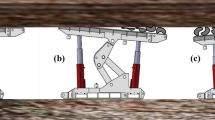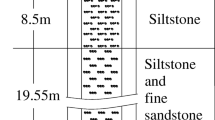Abstract
Based on the interaction between hydraulic support and surrounding rock, this paper considers that the coupling relationship between hydraulic support and surrounding rock mainly includes three parts: The strength coupling, stiffness coupling and stability coupling between the support and the surrounding rock, wherein the strength of the surrounding rock determines the load formed by the fracture and instability of the overlying strata on the working face, while the support strength and structural strength of the hydraulic support can adapt to and change the size and position of the surrounding rock load. On this basis, the instability mechanism of hydraulic support topple in fully mechanized caving face of inclined coal seam is analyzed, and the simplified model of hydraulic support ultimate topple is established. This paper analyzes the mechanism of hydraulic support dumping in the process of moving the hydraulic support in the fully mechanized caving face of inclined coal seam and establishes the critical model of hydraulic support dumping in the fully mechanized caving face of inclined coal seam. Taking No. 4101 working face of Hemei No.3 Mine and No. 2125 working face of Hemei No.6 Mine as engineering background, the hydraulic support falling control technology of fully mechanized caving face of inclined coal seam is put forward. In order to realize the intelligent coupling between hydraulic support and surrounding rock and realize intelligent attitude adjustment, inclination sensor and pressure sensor are arranged in the corresponding position of hydraulic support. By calculating and comparing the measured data, the automatic adjustment of hydraulic support attitude is realized, and then the intelligent coupling with surrounding rock top coal is realized.








Similar content being viewed by others
Data Availability
Enquiries about data availability should be directed to the authors.
References
Cheng G, Zhao JH (2021) Research on real-time monitoring technology of coal mine hydraulic support shape. China Energy Environ Prot 43(03):164–168
Gong HP, Li JW, Chen BB (2013) Overlying strata structure and surrounding rock stability of mining near-distance coal seams. Coal min Technolog 18(05):90–92
He MC (2014) Progress and challenges of soft rock engineering in depth. J China Coal Soc 39(8):1409–1417
He MC, Yuan Y, Wang XL et al (2013) Control technology for large deformation of Mesozoic compound soft rock in XinJiang and its application. Chin J Rock Mech Eng 32(03):433–441
He FL, Zhao ZZ, He SS et al (2014) Fuzzy fault tree analysis on instability of bracket-rock system in fully mechanized caving face with large cutting height. Coal Eng 46(10):158–161
Li CR (2018) Study on method of rock failure height inversion based on hydraulic support pressure value. Coal Mine Mach 39(01):22–23
Li Y, Zhang Y, Li W (2014) Reasonable working resistance determination of hydraulic support based on key strata theory. Saf Coal Mines 45(11):57–59
Liu KZ, Zeng YF, Wu YP (2010) Supporting technology of structure coupling for large section coal roadway with high water-content. J Xi’an Univ of Sci Technol 30(06):662–666
Ma Y (2016) Research on caving hydrautic support and control method for intelligent coupling with surrounding rock. Colliery Mech Electr Technol 03:8–10
Ren HW, Zhang DS, Gong SX, Zhou K, Xi CY, He M, Li TJ (2021) Dynamic impact experiment and response characteristics analysis for 1:2 reduced-scale model of hydraulic support. Int J Min Sci Technol 31(3):347–356. https://doi.org/10.1016/j.ijmst.2021.03.004
Song ZQ, Jiang YJ, Liu JK (2017) Theory and model of “practical method of mine pressure control.” Coal Sci Technol Mag 02:1–10
Wan LR, Yu XH, Zeng XT, Ma DJ, Wang JT, Meng ZS, Zhang HK (2023) Performance analysis of the new balance jack of anti-impact ground pressure hydraulic support. Alex Eng J 62:157–167. https://doi.org/10.1016/j.aej.2022.07.002
Wang GF (2010) Study and practices on technical system of hydraulic powered supports. J China Coal Soc 35(11):1903–1908
Wu FF, Yue X, Liu CY et al (2022) Movement law of overburden in steep inclined ultra thick seam and calculation of support working resistance. J Min Saf Eng 39(03):499–506
Yang P (2019a) Research on reliability evaluation and surrounding rock control technology of hydraulic supporting in thin coal seam face. China Energy Environ Prot 41(07):191–195
Yang QH, Zhao H, Li B (2021) Analysis and research on structural strength of mine hydraulic supports under dynamic mechanical conditions. China Energy Environ Prot 43(09):240–245
Yang P (2019) Study on monitoring of working resistance of hydraulic support in working face under action of “Two Hard” surrounding rock. China Energy Environ Prot 41(08):179–182
Zhang C, Yuan S, Zhang NN, Li C, Li H, Yang WY (2021) Dust-suppression and cooling effects of spray system installed between hydraulic supports in fully mechanized coal-mining face. Build Environ 204:108106. https://doi.org/10.1016/j.buildenv.2021.108106
Zhang HP (2022) Analysis on stability of overburden structure and support resistance in fully mechanized top coal caving mining—taking Baode Coal Mine as an example. Coal Science and Technology 50(S1):48–52. https://doi.org/10.13199/j.cnki.cst.2022-0820
Funding
This work was supported by the Science and technology project of Hebi Coal (Group) Company in 2021, No. 202101-kc1.
Author information
Authors and Affiliations
Contributions
QL conceived and designed the experiments; performed the experiments; analyzed the data; and wrote the paper.
Corresponding author
Ethics declarations
Conflict of interest
The authors declare no conflict of interest.
Additional information
Publisher's Note
Springer Nature remains neutral with regard to jurisdictional claims in published maps and institutional affiliations.
Rights and permissions
Springer Nature or its licensor (e.g. a society or other partner) holds exclusive rights to this article under a publishing agreement with the author(s) or other rightsholder(s); author self-archiving of the accepted manuscript version of this article is solely governed by the terms of such publishing agreement and applicable law.
About this article
Cite this article
Qi, L. Research on Intelligent Coupling Control Technology Between Caving Hydraulic Support and Surrounding Rock. Geotech Geol Eng 41, 1101–1113 (2023). https://doi.org/10.1007/s10706-022-02325-0
Received:
Accepted:
Published:
Issue Date:
DOI: https://doi.org/10.1007/s10706-022-02325-0




